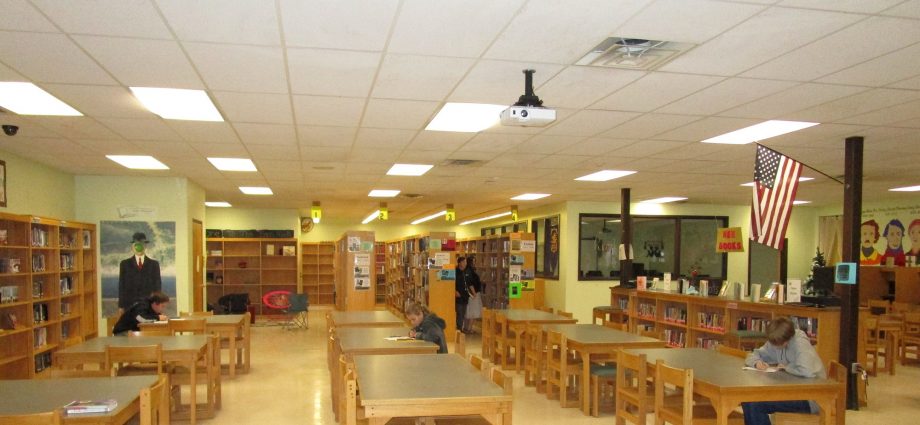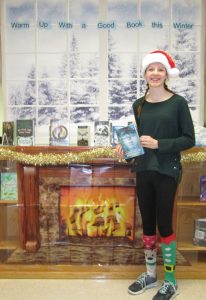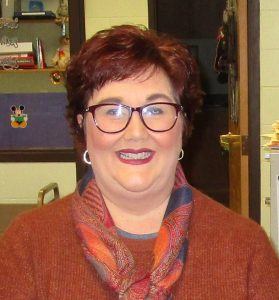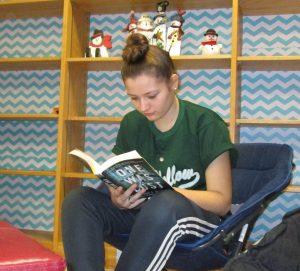The spacious library at Elk Lake High School remains popular as a study and meeting destination as well as a homeroom for a teacher who stepped up to maintain it. Library intern EmmaLeigh Buffington (above) exhibits one of the books featured for winter reading at Elk Lake High School.
Photos and story by Rick Hiduk
(Also published in the Susquehanna County Idependent)
In an age when technology seemed to be taking over many aspects of our lives or doing away completely with life as we once knew it, the days for school and public libraries appeared to numbered. Would students even want to pick up a book or newspaper when the same information might be more readily available on an electronic tablet, an iPad, or some other handheld device?
At Elk Lake High School, the questions of how to keep the library accessible, meaningful and a place where students still wanted to go loomed even larger when the district’s veteran librarian, Kris Morahan, retired at the end of the 2019 school year. Morahan was a Google-certified instructor and made sure the library was keeping up with the times. “Her technical knowledge went beyond the norm. She was our go-to for things like that,” high school principal John Warnero remarked. “When she retired, the district had to get creative.”
As the school’s yearbook adviser, Morahan was able to integrate aspects of page layout, working with photos, and other aspects of publishing that weren’t traditionally part of library curriculum. “She made it a hub for a lot of activities,” Warnero said of Morahan’s success at keeping the students engaged.
The district elected not to hire a new librarian, however. Junior high school language arts instructor Marie Michalek shared the concern of many that the library’s purpose might fade away as the students became disenchanted with a “big room full of books.”
Michalek worked with administrators to modify her job description and, subsequently, the function of the library. “She took her passion for reading and books and combined it with her teaching duties and took on much of what our library entails,” Warnero explained. The library, in effect, was absorbed into the language arts curriculum. Michalek (below) still teaches five reading classes per day, but she now does so from the library.
“I wanted to be sure that the programs the library had stayed in place and that we didn’t lose any services,” Michalek related, admitting that she had “big shoes to fill” but is succeeding with the help of other faculty members like paraprofessional Jen Teel, student intern EmmaLeigh Buffington, and two dozen additional students who run the library while Michalek teaches in the adjacent room.
The students check in returned books and reshelve them. They look for research materials upon request and assist with seasonal decorations that generally parallel a new reading campaign. “I would not be able to do it without the volunteers,” Michalek maintains.
EmmaLeigh gets credit for the time she spends in the library as an independent study program. “I had study halls, but I decided I’d rather do this,” the sophomore explained. “I like books, and I like being in the library.” EmmaLeigh pointed to a “tree” of research and holiday books she had erected next to the front desk and said that she is eager to learn how to put new books into the system.
As might be expected, the library offers a mix of traditional printed and digital resources, the latter of which includes a free reading app by which students can download e-books and audio books to their smart devices. In addition to the seasonal displays of suggested reading material, Michalek recently served up an exercise in “book tasting.”
“The library was essentially transformed into a restaurant where students were seated at a table set with placemats, napkins and place cards and a menu,” Michalek explained. “Each ‘course’ of the ‘meal’ required students to ‘taste’ a different genre in hopes of sparking an interest in a book that might not have otherwise read.”
The library receives several local newspapers each week, and Michalek incorporated the classic medium into a lesson plan and challenged her students to compose a report in the style of a newspaper article to coincide with the book through which the class was working.
Circulation of library materials remains steady, even though the number of students in the library at any given time has decreased a bit. “There are less older students – maybe because it isn’t as social as it used to be,” Michalek noted. “Other’s come down because they know it is a quiet space to study.” There is a “no cell phone” rule in the library, and a corner farthest away from the learning lab where Michalek teaches is called the Book Nook, featuring low-slung, comfortable chairs where students can read without distractions. Students can also come to the library to take tests they have missed.
“The ultimate goal of the high school library is to be able to meet the literacy needs of all students through a variety of resources in an attempt to accommodate all learning styles and the ever-changing technological needs of the modern student,” Michalek stated.
So far, shifting elements of the language arts program to the library is an experiment with which administrators are happy. “We’re learning along the way some of the adjustments we need to make to address scheduling and availability,” related Warnero, who credited Michalek for keeping the library from falling behind. “She has done a phenomenal job of maintaining the system of what she believes a library can be.”
In the long term, Warnero hopes that more Michalek’s teaching schedule can be freed up so she can concentrate even more on the library.
Elk Lake eighth grader Matisyn Lord relaxes with a copy of a suspenseful, teen-centered mystery by Natalie D. Richards titled “One Was Lost.”



